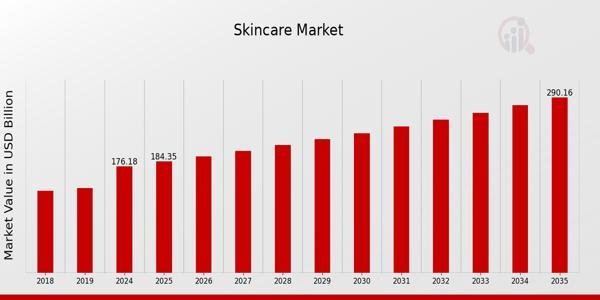The Skincare Market: Insights and Future Growth Prospects
The skincare market is undergoing a significant transformation, with tremendous growth expected in the coming years. As of 2023, its valuation stands at approximately $168.38 billion, with projections indicating it could surge to $290 billion by 2035. This growth, driven by a compound annual growth rate (CAGR) of 4.63% anticipated from 2025 to 2035, is attributed to evolving consumer preferences and advancements in product formulation.
Rising Trends Fueling Market Expansion
Consumer Awareness and Preferences
Consumers are increasingly well-informed about skincare products, prioritizing formulations that feature natural and organic ingredients. This trend aligns with a broader global movement toward self-care, wellness, and ethical consumption.
Important factors influencing this evolution include:
- Increased Knowledge: Consumers are now more ingredient-conscious, seeking products tailored to their specific skin types and concerns.
- Social Media Influence: Platforms like Instagram and TikTok play pivotal roles in shaping buying decisions, highlighting the popularity of specific products and routines.
Market Segmentation: Product Types
The skincare market encompasses a variety of product categories, each experiencing unique growth trajectories:
- Moisturizers: The leading product type, appreciated for their versatility across all skin types. Ingredients such as hyaluronic acid and ceramides contribute to their rising popularity.
- Serums: Currently the fastest-growing segment, serums utilize concentrated active ingredients like retinol, niacinamide, and vitamin C for targeted skincare solutions.
- Cleansers and Sunscreens: There is a growing preference for gentle, pH-balanced cleansers that preserve the skin’s natural oils. Meanwhile, the rising awareness of UV protection has boosted sunscreen sales.
- Exfoliators: Chemical exfoliants, such as AHAs and BHAs, are increasingly favored for their effectiveness in promoting skin cell renewal.
Tailored Solutions for Diverse Skin Types
Understanding Skin Type Dynamics
The demand for skincare products is notably segmented by skin type, allowing for tailored beauty solutions:
- Oily and Combination Skin: Particularly sought after in warm climates, products aimed at controlling oil and shine feature ingredients like salicylic acid and green tea.
- Sensitive Skin: The increasing need for hypoallergenic and dermatologist-tested products responds to concerns over pollutants and allergens.
- Dry Skin: Common in aging populations, treatments featuring shea butter and squalene offer comforting hydration.
Personalized Beauty Experience
Advancements in technology and diagnostics have made personalization more accessible, enhancing consumer experiences by meeting individual skin needs.
Gender Dynamics in Skincare
Historically dominated by female consumers, the skincare market is experiencing considerable growth in male grooming and unisex products. This shift is driven by changing societal norms regarding self-care and grooming, with men increasingly purchasing a range of skincare essentials.
Highlights include:
- Dedicated Men’s Lines: Brands are launching products specifically designed for men’s skin to cater to this growing segment.
- Unisex Products: Minimalistic designs and neutral scents appeal to younger consumers who value inclusivity and sustainability.
The Clean Beauty Revolution
Ingredient Preferences
The rising trend toward clean beauty is shaping consumer choice, with a preference for:
- Natural Ingredients: Demand for plant-based components such as aloe vera, tea tree oil, and jojoba oil is surging.
- Active Ingredients: Scientific-backed formulations featuring niacinamide and retinoids remain popular for their visible skin benefits.
Sustainability in Skincare
Consumer attitudes are shifting towards brands that prioritize environmental responsibility, prompting a significant focus on ethical sourcing and cruelty-free practices.
Regional Insights: Market Landscape
The global skincare market is compartmentalized into distinct regions, each presenting unique challenges and opportunities:
-
Asia-Pacific: Leading the market with innovation and widespread acceptance of advanced skincare routines—countries like South Korea set global trends.
-
North America: A strong player characterized by high consumer spending on beauty and wellness, emphasizing clean beauty and multifunctional products.
-
Europe: Focused on product quality and sustainability, Europe leverages its legacy of heritage brands.
- South America and the Middle East & Africa: These emerging regions are seeing steady growth through urbanization and improved living standards.
Key Drivers and Market Trends
Several macro and micro factors are accelerating the skincare market:
- Healthcare and Beauty Awareness: Heightened interest in holistic wellness drives consumer investment in skincare.
- Influences from Social Media: Platforms like YouTube and Instagram affect buying decisions, promoting effective skincare routines.
- E-commerce Growth: The rise of online retail and direct-to-consumer models enhances product availability.
- Technological Innovation: AI and smart technologies are enhancing personalized consumer experiences.
Conclusion: Future of Skincare
With a growing customer base and a relentless pace of product innovation, the skincare market is poised for long-term growth. The integration of wellness and beauty will redefine how consumers view skincare, establishing it as an essential component of overall health.
For more in-depth insights into the skincare market, including forecasts and detailed analysis, visit Market Research Future.
The skincare industry continues to evolve, driven by consumer preferences, advancements in technology, and a commitment to sustainable practices. Embrace the changes and find the products that truly work for you!


